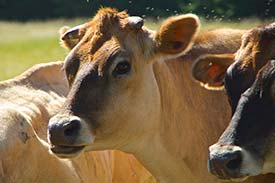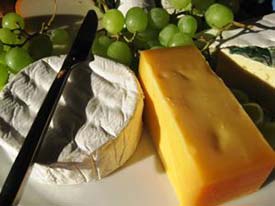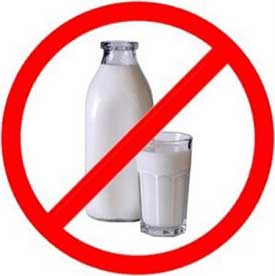Got milk?
 Recently in my nutrition course I asked how many students regularly consume dairy products. I was surprised by the response.
Recently in my nutrition course I asked how many students regularly consume dairy products. I was surprised by the response.
About 125 of the 200 or so students said they drink milk and eat cheese on a regular basis. About 75 said they consumed no milk or cheese because they were lactose intolerant (approximately 25 students) or they hated the taste — “always have and always will,” as one student exclaimed. One student raised his hand and told me his mother is a cancer researcher. She would not permit anyone in his family to consume dairy, particularly cows’ milk, because her research suggested it caused cancer in humans. This student then proceeded to ask, “Is my mother correct?”
What a loaded question! I begged off and changed the topic.
Different types of dairy products
Dairy represents any food produced from the milk of mammals. And apart from breastfed infants, human consumption of dairy products is sourced primarily from the milk of cows, goats, sheep, yaks, horses, camels, water buffaloes, and domestic buffaloes. Dairy products are usually high energy-yielding foods commonly found in European, Middle Eastern, and Indian cultures. They are little known in traditional East Asian regions – with Mongolia as one key exception.
The number of dairy products found around the globe is enormous. Products generally fall into broad categories:
- Milk, Butter, Cheese, Caseins (80 percent of proteins in cows’ milk)
- Yogurts (fermented milk)
- Clabber (milk naturally fermented to a yogurt-like state)
- Gelato (slowly frozen milk and water)
- Ice Cream (slowly frozen cream)
Each type of product contains differing amounts of water, lactose, fat, protein, carbohydrates, cholesterol, minerals, and vitamins. Dairy products are high-energy and high-protein foods rich in calcium. They tend to be high in fat. The USDA lists dairy as one of “the five food groups,” alongside fruits, vegetables, grains, and protein foods as part of their MyPlate dietary recommendations for Americans. How dairy became a food group (which it is not) is another story I will address in a future Health Yourself column.
Dairy health concerns
 In the 1950s researchers began to study patterns of dairy consumption and subsequent development of cancer, diabetes, obesity, osteoporosis, dementia, arthritis, and other chronic diseases. Papers appeared in some of the most prestigious medical journals, reporting casual and sometimes causal relationships between the amount of dairy consumed and the onset/severity of disease. At first it was easy to dismiss much of this research as exploratory and poorly conducted. Critics cited inadequate controls, small sample sizes, and researcher bias.
In the 1950s researchers began to study patterns of dairy consumption and subsequent development of cancer, diabetes, obesity, osteoporosis, dementia, arthritis, and other chronic diseases. Papers appeared in some of the most prestigious medical journals, reporting casual and sometimes causal relationships between the amount of dairy consumed and the onset/severity of disease. At first it was easy to dismiss much of this research as exploratory and poorly conducted. Critics cited inadequate controls, small sample sizes, and researcher bias.
But recent advances in molecular and biochemical research techniques help clarify the argument around possible health concerns of dairy consumption. The ability to isolate variables helps researchers zero in on the causes and effects regarding different aspects of dairy and disease. In addition, longitudinal and cross-cultural data are more readily available today.
I would like to briefly review a few of the findings regarding dairy and cancer. It’s a flash-point area rich in controversy and misinformation.
Dairy, prostate cancer, and osteoporosis
Remember the “Got Milk” advertising campaign by the Milk Processor Education Program? Supermodels, superstar athletes, and celebrities were pictured sporting frothy milk mustaches to add a little sex appeal to milk while promoting its “nutritional benefits,” especially its high levels of calcium. Well, the campaign recently got a makeover. The new “Milk Life” version takes the focus off milk’s calcium content and bone-strengthening properties. Now it promotes milk as a good source of protein.
Why the change? I believe it is, in part, due to declining milk sales and closely related to recent studies linking milk (particularly) and other dairy consumption to increased risks and rates of prostate, testicular, and possibly ovarian and breast cancer.
 In the case of prostate cancer, researchers first thought the high fat content of whole milk, cheese, yogurt, and other dairy might be responsible for the increased risk. But much of the research points to high levels of calcium, which lowers Vitamin D. Vitamin D helps protect against heart attack, diabetes, stroke, obesity, and muscle weakness. Moreover, consistent research shows dairy increases levels of insulin-like growth factor 1 (IGF-1) in the bloodstream. IGF-1 promotes growth of cancer cells and causally links to increased risk of prostate and breast cancer.
In the case of prostate cancer, researchers first thought the high fat content of whole milk, cheese, yogurt, and other dairy might be responsible for the increased risk. But much of the research points to high levels of calcium, which lowers Vitamin D. Vitamin D helps protect against heart attack, diabetes, stroke, obesity, and muscle weakness. Moreover, consistent research shows dairy increases levels of insulin-like growth factor 1 (IGF-1) in the bloodstream. IGF-1 promotes growth of cancer cells and causally links to increased risk of prostate and breast cancer.
The most recent Physicians Health Study at Harvard, University of California-Berkeley, and McGill University in Quebec seems to confirm the dairy-calcium-prostate-cancer connection. Researchers tracked the dairy consumption of more than 20,000 male physicians over a 28-year period. Those who consumed more than two servings of dairy per day had a 34 percent higher risk of developing prostate cancer than men who consumed very little or no dairy products. The authors recommended “minimal intake” of whole-fat dairy foods, especially among elderly men and prostate cancer survivors.
Regarding dairy and osteoporosis, the data show that osteoporosis is a disease caused by a number of things, the most important of which may be high intakes of animal protein. The correspondence is direct and consistent. Even with high calcium intakes, the more excess animal protein in the diet the greater the incidence of negative calcium balance and the greater loss of calcium from bone. World health statistics show osteoporosis is most common in those countries where dairy products are consumed in the largest quantities: the United States, Finland, Sweden, and Britain.
Dairy and breast, ovarian, and lung cancer
The relationship between dairy intake and breast, ovarian, and lung cancer is another area of intense debate and controversy. A highly cited early study in 1989 examined per-capita milk consumption among 27 countries. Researchers found it positively associated with ovarian cancer risk. However, subsequent studies have reported inconsistent and inconclusive results. Since most studies use questionnaires to determine levels of dairy consumption, measurement error may partly explain inconclusive and conflicting data when comparing cancer risks among those with high dairy consumption to those with low dairy consumption.
 A recent study that took a novel approach to this problem adds clarity to the question of the role of dairy and cancer. In this first-of-a-kind 2014 study by researchers from Malmo, Sweden, and Stanford University, lung, breast, and ovarian cancer rates in individuals with lactose intolerance (with long-term “low dairy consumption”) were compared to first-degree relatives (siblings and parents without lactose intolerance) who consumed “normal” amounts of dairy-rich foods. This unique research approach is able to exclude potential confounding factors, which are difficult to control in typical cross-sectional studies. The researchers identified 22,788 individuals with lactose intolerance from several Swedish registers linked to the Swedish Cancer Registry and calculated cancer incidence in the breast, lung, and ovary.
A recent study that took a novel approach to this problem adds clarity to the question of the role of dairy and cancer. In this first-of-a-kind 2014 study by researchers from Malmo, Sweden, and Stanford University, lung, breast, and ovarian cancer rates in individuals with lactose intolerance (with long-term “low dairy consumption”) were compared to first-degree relatives (siblings and parents without lactose intolerance) who consumed “normal” amounts of dairy-rich foods. This unique research approach is able to exclude potential confounding factors, which are difficult to control in typical cross-sectional studies. The researchers identified 22,788 individuals with lactose intolerance from several Swedish registers linked to the Swedish Cancer Registry and calculated cancer incidence in the breast, lung, and ovary.
The data were clear with no ambiguity. Individuals with lactose intolerance, characterized by low consumption of milk and other dairy products, had significantly and substantially decreased risks of lung, breast, and ovarian cancers. Decreased cancer risks were not found in the family members (without lactose intolerance) who had increased dairy consumption. Of course, such individual-level risk factors as smoking, alcohol consumption, other dietary habits, psychosocial factors, and sociocultural behaviors also could be involved as contributing factors to increased cancer risks.
What to make of all of this?
An 8-oz. glass of milk has nearly 300 mg of calcium – and it doesn’t matter if it’s whole, skim, or 1 percent – they all have between 291 and 300 mg of calcium per 8-oz. glass. Other foods, perhaps, offer a healthier way to get calcium in much lower doses. Kale, broccoli, bok choy, mustard and collard greens, figs, almond milk, and soy milk are good sources of calcium and other cancer-fighting nutrients.
Admittedly, while each passing decade has introduced new controversies (and findings) concerning food and disease, based on current research it appears prudent to limit dairy intake.
References:
- Boyd, N.F., et al. A meta-analysis of studies of dietary fat and breast cancer risk. Br J Cancer, 1993; 68(3):627.
- Cramer, D.W., et al. Lactase persistence and milk consumption as determinants of ovarian cancer risk. American Journal of Epidemiology; 1989; 130(5):
- Dong, J.Y., et al. Dairy consumption and risk of breast cancer: a meta-analysis of prospective cohort studies. Breast Cancer Res Treat, 2011; 127(1): 23.
- Genkinger, J.M., et al. Dairy products and ovarian cancer: a pooled analysis of 12 cohort studies. Cancer Epidemiol Biomarkers Prev, 2006; 15(2): 364.
- Ji, J. Lactose intolerance and risk of lung, breast, and ovarian cancers: Aetiological clues from a population-based study in Sweden. Br. J. Cancer. 2014, 1-4.
- Kroenke, C.H., et al. High- and low-fat dairy intake, recurrence, and mortality after breast cancer diagnosis. JNCI J Natl Cancer Inst. 2013);105(9): 616.
- Larsson, S.C., Bergkvist, L, Wolk, A. Milk and lactose intakes and ovarian cancer risk in the Swedish Mammography Cohort. American Journal of Clinical Nutrition. 2004; 80(5):1353.
- Larsson, S.C., et al. Milk, milk products and lactose intake and ovarian cancer risk: A meta-analysis of epidemiological studies. International Journal of Cancer. 2006; 118(2): 431–441.
- Michaelsson, K; Wolk, A; Langenskiold, S.; et al. Milk intake and risk of mortality and fractures in women and men: Cohort studies. BMJ. 2014;349:g6015.
- Richman, E.L., et al. Milk and dairy Consumption among men with prostate cancer and risk of metastases and prostate cancer death. Cancer Epidemiol. Biomarkers Prev. 2012; 21: 428.
- Song, Y., et al. Whole milk intake is associated with prostate cancer-specific mortality among U.S. male physicians. Journal of Nutrition. 2013; 143: 189.
- World Cancer Research Fund PA. Food, nutrition, physical activity and the prevention of cancer: a global perspective. American Institute for Cancer Research: Washington, DC, USA. 2007.
- Youngman, L.D.; Campbell, T.C. Inhibition of aflatoxin B1-induced gamma-glutamyltranspeptidase positive (GGT+) hepatic preneoplastic foci and tumors by low protein diets: Evidence that altered GGT+ foci indicate neoplastic potential. Carcinogenesis. 1992;13:1607.



Hannah Lozon - 2006
My ND recently diagnosed a dairy allergy (specifically to the casein protein), which really transformed my life. The allergy was causing an annual case of strep throat, acne, chronic bacterial vaginosis, and a horrible morning cough. I never really liked much dairy besides milk chocolate, ice cream, and pizza (no other cheese)….now I know why. Thank you for this article, it gives me more reason to avoid dairy!
Reply
Karen Markey
Thanks Vic for an interesting piece. Personally I’ve switched to almond milk, low calorie, no cholesterol, and good tasting. I haven’t found a substitute for cheese or chocolate yet.
Reply
Miriam Janov
I’m curious if in your research there was any discussion of the many health and immunity-boosting benefits of consuming raw milk and dairy products (particularly from grass-fed pastured animals)? While on the surface this appears to be a thorough investigation of current research findings, I am compelled to point out the gaping holes in your blanket warning against dairy consumption. I urge you to revisit your research and expand its scope to include the multitude of data illustrating the vast health benefits of consuming raw, nutrient-dense food. Or atleast place a disclaimer on your concluding statement to address/clarify the specific kind of dairy (i.e. raw vs processed) you are strongly cautioning against.
Reply
Steve Bean
In addition to Miriam’s constructive feedback, I wonder about possible differences between organically raised and conventionally raised dairy products.
Reply
Mark Gascoigne - 1966
What is so bad about calcium? Calcium supplements have about four times the calcium and the Vitamin D to help absorb it than an 8 oz. glass of milk
Is this article saying that calcium is not good for you? Is it saying (appears to) that milk has too much calcium. For example the statement
“…get calcium in lower doses from…”
Reply
Nick Yordanov - 2013
The trick with dairy products is to consume little from some and moderate from other. Milk should be avoided the most as its lactose is in its most active state. The better options would be cheese and especially yogurt, since they undergo bacteria fermentation and become easier digested by the gut. Still, it’s perhaps wise not to over consume dairy products, as side effects may be overwhelming to certain individuals. If some of you are curious to learn more, here’s a very detailed article about the topic: https://organicpowerfoods.com/health-topics/side-effects-of-too-much-dairy-intake
Reply